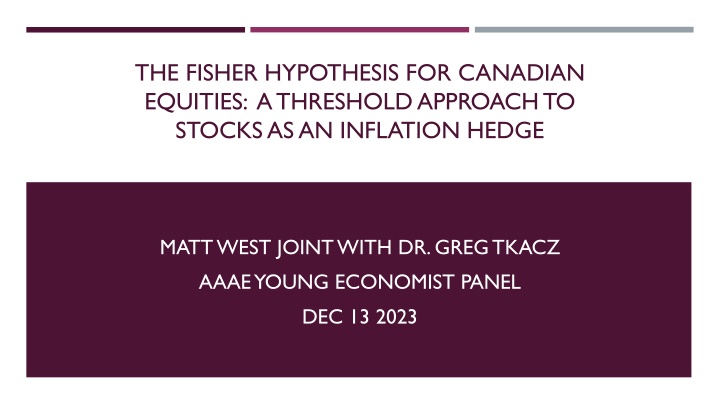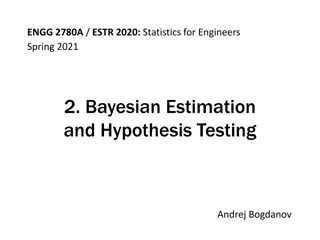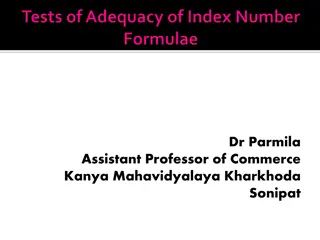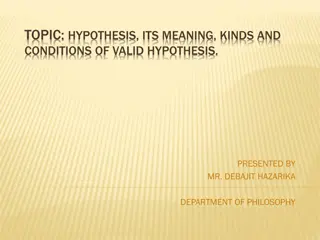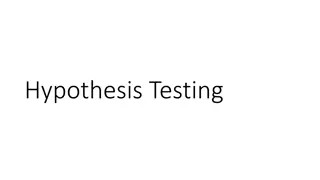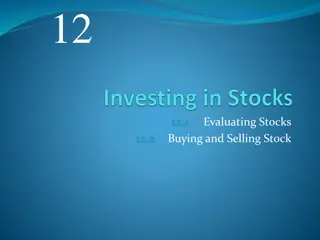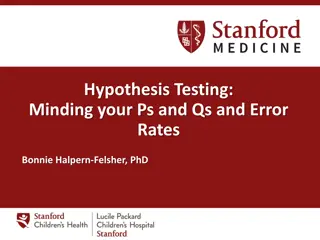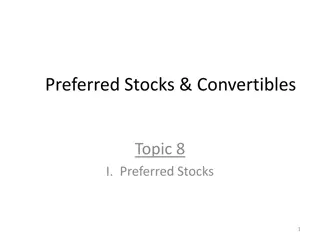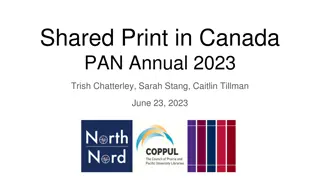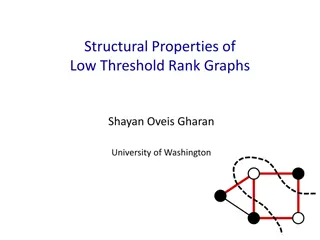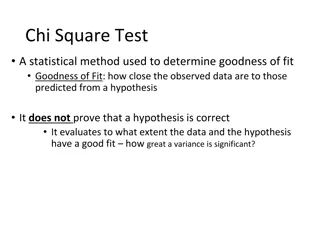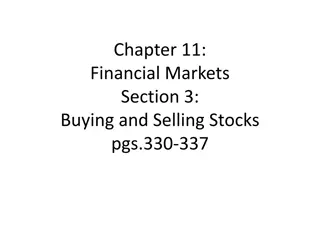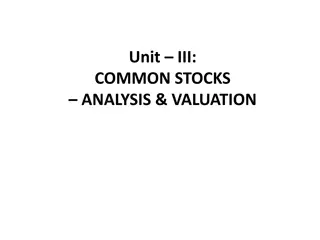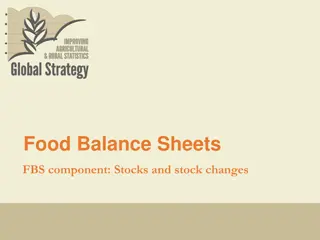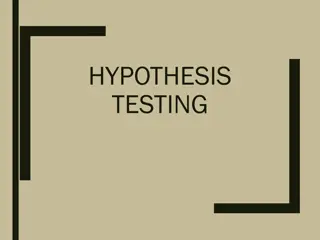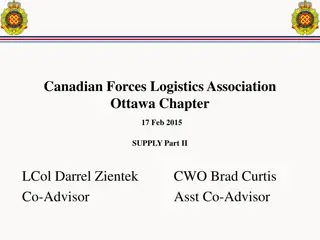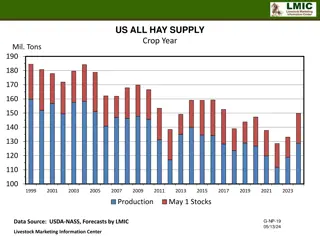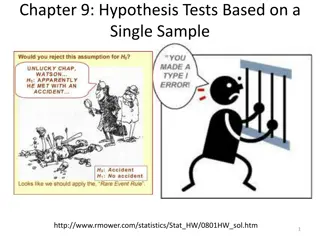The Fisher Hypothesis for Canadian Equities: A Threshold Approach to Stocks as an Inflation Hedge
The Fisher Hypothesis examines the relationship between inflation and real stock returns, suggesting that stocks can act as an inflation hedge. This study delves into the theory, econometric analysis, Canadian and US data comparisons, results, and implications for investors. Previous studies both support and challenge the hypothesis, with newer research exploring threshold models for a nuanced understanding.
Download Presentation

Please find below an Image/Link to download the presentation.
The content on the website is provided AS IS for your information and personal use only. It may not be sold, licensed, or shared on other websites without obtaining consent from the author.If you encounter any issues during the download, it is possible that the publisher has removed the file from their server.
You are allowed to download the files provided on this website for personal or commercial use, subject to the condition that they are used lawfully. All files are the property of their respective owners.
The content on the website is provided AS IS for your information and personal use only. It may not be sold, licensed, or shared on other websites without obtaining consent from the author.
E N D
Presentation Transcript
THE FISHER HYPOTHESIS FOR CANADIAN EQUITIES: A THRESHOLD APPROACH TO STOCKS AS AN INFLATION HEDGE MATT WEST JOINT WITH DR. GREG TKACZ AAAEYOUNG ECONOMIST PANEL DEC 13 2023
TABLE OF CONTENTS 1. Introduction 2. Theory & Econometric Specification 3. Data: Canadian & US Variables 4. Results 5. Conclusions and Highlights 6. Future Work 2
1. STOCKS AS AN INFLATION HEDGE The Fisher Hypothesis generally states that, for any financial asset, its expected nominal rate of return for any period t can be decomposed into an expected real rate of return and expected inflation rate: ? ? ? ??+1 = ??+1 + ??+1 If the Fisher Hypothesis holds, then any increase in the expected inflation rate should be reflected in a one-for- one higher nominal rate of return, making the asset a good inflation hedge. A common test of the Fisher Hypothesis relates to the relationship between inflation expectations and real returns: If the Fisher Hypothesis holds, then real returns should not respond to changes in inflation expectations. 3
WHY SHOULD YOU CARE? Periods of high inflation erode the purchasing power of your savings. Insulating your savings from inflation negates this impact. Beyond Real Return Bonds (RRBs), ordinary investors lack a widely accessible, guaranteed inflation protected security. As a result, they have to look elsewhere to shield their savings. Common stocks have no guaranteed return, but if the Fisher Hypothesis holds, it suggests that historically speaking, they do provide that inflation-insulated return. 4
PREVIOUS STUDIES Empirically, the Fisher Hypothesis has been rejected for stocks by some early studies. Many of these found a negative relationship between inflation (or inflation expectations) and real stock returns; see, e.g. Nelson (JF 1976), Bodie (JF 1976), Fama & Schwert (JFE 1977), Fama (AER 1981), etc. Excluding Fama, attempts to explain the negativity between real stock returns and inflation relied on a causal relationship between inflation expectations and real stock returns Some more recent studies, however, have found some support for the Fisher Hypothesis as it relates to stocks. For example, Kim & Ryoo (EL 2011) can t reject the Fisher Hypothesis when they examine stock prices and inflation over a period spanning more than a century. Katzur & Spierdijk (AFE 2013) and Lee & Wang (QFE 2017) also find some support, especially when non-linear (threshold models) are used. 5
PREVIOUS STUDIES Bruno and Chincarini (RFE 2010): Standard Markowitz approach to portfolio construction but now conditional on real returns. Their optimal portfolio had no equity allocation, instead opting for a mix of fixed income and commodity exposures. A number of works have explored a factor approach measuring an inflation risk premium. Boucher (EL 2006) estimates a P/E to inflation risk premium factor, Schmitz (QJBE 1996) demonstrated the effectiveness of a number of economic factors, including inflation when expanding from a simpler financial factor model. 6
2. ECONOMETRIC SPECIFICATION We followed the model specification used by Cozier & Rahman (CJE 1988) for Canada Notation: Nominal (ex post) and expected (ex ante) stock return formed at t-1: Rt and E(Rt) Real ex post and ex ante stock return: rt and E(rt) Inflation, ex post and ex ante: tand ( t) Unexpected inflation: t = t E( t) 7
ECONOMETRIC SPECIFICATION (CONTD) (1) Fisher Hypothesis for stocks: E(Rt) = E(rt) + E( t) (2) Ex post stock return can be written as the sum of the expected value and a random shock: Rt = E(Rt) + t (3) Decomposing inflation: t = E( t) + t (4) Ex post real stock return: rt = Rt t (5) Combining (1) through (4): rt = E(rt) t + t Assuming E(rt) is constant, then the linear econometric specification is (6) rt = 0 + 1E( t) + 2 t + t The threshold specification then becomes (7) ??= ?0+ ?1?? 1+ ?2? ?? + ?3??? ? ?? ? + ?4?? 1+ ?5? ?? + ?6???(? ?? < ?) Where 1 1( )is an indicator function, taking on 1 if the argument is met and zero otherwise and ? is a given threshold level 8
4. DATA We estimate (7) using the measures of expected and unexpected inflation produced by 7 different models. AR, ARMA, VAR, FAVAR, Diffusion indices Our full sample spans 1975 to 2022, utilizing both quarter-over-quarter and year-over-year estimates We also present results for pre-Inflation-Targeting (pre-IT) up to 1998, and post-IT, from 1998 onwards. US variables will also be used in the Canadian model both in isolation and conjunction with Canadian variables 9
Quarter-over-Quarter Full Sample AR CANADA: Visually, the DI model is better capturing the magnitude of the turning points ACTUAL & PREDICTED INFLATION Quarter-over-Quarter Full Sample Canadian loaded DI AR & DI, Q/Q 10
Year-over-Year Full Sample ARMA Predicted values are dominated by lagged inflation CANADA: ACTUAL & PREDICTED INFLATION Year-over-Year Full Sample American Loaded DI Model actually seems to be picking-up the turning points AR & DI, Y/Y 11
5. RESULTS: YEAR-OVER-YEAR Expected Inflation coefficient Estimates Full Sample High Regime Low Regime Threshold AR(6) 8.26 7.51 7.41 7.65 8.4 7.5 6.24 -0.35 -0.35 -0.29 -0.35 -0.29 -0.30 -0.35 -0.74 -0.72 -0.84 -0.78 -0.75 -0.58 -4.57 ARMA(6,3) VAR(5) Fisher hypothesis categorically supported in the low expectations regime across every decomposition model Canadian PC VAR(5) American PC VAR(9) Canadian DI(8) American DI(8) Pre-IT AR(6) Full Sample and Pre-IT periods also produced evidence in support of Fisher hypothesis 8.26 8.74 7.58 7.68 7.79 7.52 6.82 -0.32 -0.38 -0.42 -0.47 -0.51 -0.49 -0.52 -0.20 -0.30 -0.66 -0.64 -0.77 -0.66 -0.66 ARMA(6,3) Canadian VAR(5) Canadian PC VAR(5) American PC VAR(9) Canadian DI(8) American DI(8) Surprisingly, the Post-IT high regime coefficients reject the Fisher hypothesis in 5/7 decomposition models Post-IT AR(1) ARMA(5,3) 1.22 2.08 1.38 1.71 1.09 2.07 1.72 -3.41*** -2.28** -2.62** -2.90** -2.55** -1.17 -1.37 0.28** -2.87 -2.87 -3.11 -5.40 0.28 0.16 Canadian VAR(2) Canadian PC VAR(1) American PC VAR(2) Canadian DI(4) American DI(4) 12
RESULTS: QUARTER-OVER-QUARTER Expected Inflation coefficient Estimates Full Sample High Regime Low Regime Threshold AR(4) 1.77 1.64 1.17 1.81 1.79 0.49 2 -0.54 -0.50 0.50 -0.40 -0.37 -0.43 0.59 -0.83 -1.45 -1.38 -1.69 -0.73 2.17 2.63 ARMA(8,3) Canadian VAR(1) Canadian PC VAR(1) American PC VAR(2) Canadian DI(4) American DI(4) Fisher hypothesis supported in 95% of low regime estimates, Post-IT AR(3) is the notable exception Pre-IT AR(1) High regime categorically supports Fisher hypothesis. 2.23 2.19 2.08 2.2 2.34 1.96 1.85 -1.03 -0.32 -0.12 -0.72 -0.82 -1.14 -0.51 0.12 -0.46 -1.11 -0.86 0.31 -1.00 -0.34 ARMA(5,2) Canadian VAR(2) Canadian PC VAR(1) American PC VAR(2) Canadian DI(4) American DI(4) The threshold level is considerably lower for all Post-IT estimates (unsurprising) but well below 2% annualized for AR(3) and the American DI Post-IT AR(3) 0.24 0.84 0.91 0.42 0.56 0.62 0.24 -2.41 -0.15 0.71 0.71 1.15 0.52 -0.37 -27.58** 0.05 0.82 4.42 -2.18 2.79 -0.11 ARMA(3,3) Canadian VAR(2) Canadian PC VAR(2) American PC VAR(2) Canadian DI(4) American DI(4) 13
7. CONCLUSION & HIGHLIGHTS 6. Conclusion and Highlights The impact of inflation expectations on real stock returns failed to produce significant results in 86% of the inflation decomposition models tested, suggesting that the Fisher hypothesis is broadly supported for Canadian equities The notable outlier was the Post-IT YoY era which was slightly surprising given the tame dynamics inflation exhibited during the period A novel contribution to the literature was employing diffusion indices to the the inflation decomposition stage, across every sample, the DI estimates for inflation expectations were insignificant. Given that DIs draw on the broadest information set, their results should be considered the most robust Supportive evidence for the Fisher hypothesis in the Pre-IT subsamples differs from original works in the field. Comparisons of linear and threshold estimates suggest that previous specifications overlooked non-linearities in the relationship between real stock returns and inflation expectations. 14
7. FUTURE WORK I followed the threshold estimation method of Lee and Wang (2017), which was simply to establish the threshold such that the SSE was minimized. It would be interesting to see how the impact of expectations varies if the threshold is set according to the distribution of expected inflation. A strict transition was enforced between each regime, i.e. an observation fell exactly into the high/low regime. The switch may be more prolonged, the use of a STARX model would aid in addressing this. A considerable portion of the novelty of our approach lies in the extension of inflation decomposition beyond adaptive expectations. Extending to VAR,VARX and diffusion indices provided interesting results for Canada, we think it would be interesting to employ the same framework to a broader set of countries. We could then combine the panel approach of Lee and Wang (2017) with the more complex decomposition models we estimated. 15
ECONOMETRIC SPECIFICATION (CONTD) The inputs of both expected and unexpected inflation from equations 8-12 introduces Generated Regressor Bias (GRB) which produces artificially low standard errors To correct GRB, bootstrapping is employed in the following fashion: ??= ?0+ ?1?? 1+ ?2? ?? + ?3??? ? ?? ? + ?4?? 1+ ?5? ?? + ?6???(? ?? < ?) 1. ?(?)? is contained in ?(?) is estimated, producing the biased ??s and the residual error, ?(?)? where each 2. Create bootstrapped exogenous variables (?? ,?? ) by resampling in pairs with replacement from the original explanatory variables and a random draw from ?(?), ??* such that (?? ,?? ) = ?? 1 ,? ??,??,?? where ??* = ?0+ ?1(?)?? 1 + ?5(?)? ?? + ?6(?)???(? ?? < ?) + ??*17 + ?2(?)? ?? + ?3(?)??? ? ?? ? + ?4(?)?? 1
3. INFLATION DECOMPOSITION We consider five different inflation forecasting models. The predicted forecasted values provide our measure of expected inflation, and the forecast errors are the measures of unexpected inflation. Specifications 1 through 2 are standard time-series approaches that rely solely on lagged inflation (adaptive expectations). ? (8) AR: ??+1 = ?0+ ?=1 ???? ?+ ??+1 ? ? (9) ARMA: ???? ?+ ??+1 ??+1= ?0+ ?=1 ???? ?+ ?=1 Specification 3 and 4 are vector autoregressions, with and without exogenous variables. (10) VAR: ??+1= + ?(?)??+ ??+1 VARX: ??+1= + ?(?)??+ ? + ??+1 (11) Specification 5 is a diffusion index model that uses the broadest information set to predict inflation. (12) DI: ??+1= ? ? ??+ ? ??+ ??+1 18
ECONOMETRIC SPECIFICATION (CONTD) (?), b = 1 10 000 3. Repeat step 2. 10 000 times, producing the bootstrapped coefficients, ??,? 4. Calculate the bias corrected coefficients: 1 ??,?(?) = 10000??,? 10000 ?=1 ? to estimate the standard deviations 2??? 5. Utilize the bootstrapped sampling distribution for ??,? ??)2 ? ?=1 (??,? ? 1 19
